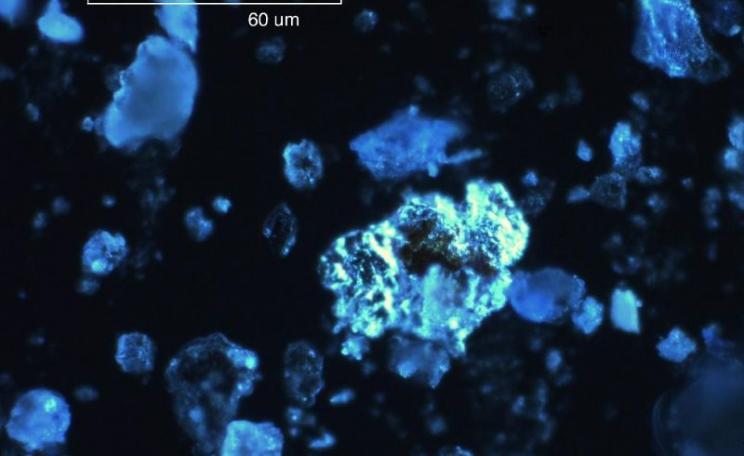The radioactive hazard arises from residual particles, dust and other contamination from the highly radioactive fuel elements the canisters stored. So the discharges will bear radioactive isotopes both in solution and as insoluble fine particles.
I recently wrote about how we could stop releases of radioactivity to the environment by using existing UK and European law.
Here I will apply this to a current situation: the application of Magnox PLC to pump radioactive waste into the estuary of the River Blackwater in Essex.
This is something that we can and should stop, and I will finish this article by explaining how.
First, there are a lot of activists down there who have recognised for a long time that the contamination of the Blackwater by Bradwell's radioactive emissions, both liquid and gaseous, has caused harm to the health of those living near the saltings and mudflats.
In 2000 I was approached by one of these groups and asked to carry out the same ward population-based breast cancer mortality study that I had done at Hinkley Point.
The result showed a doubling of breast cancer risk in those wards adjacent to the estuary, relative to distant wards and also relative to wards adjacent to the River Crouch, a similar muddy estuary to the south with no nuclear site discharging into it. (The risk map is shown in Figure 1, right.)
Essex Health Authority paid the Small Area Health Statistics Unit at Imperial College (SAHSU) some £35,000 to carry out the same study. Their report found there was no such effect. The Committee on Medical Aspects in the Environment (COMARE) looked at both studies and found some errors in both studies, mine and SAHSU's.
I re-did my study and found that when the (trivial) errors were removed, the effects were even stronger than I had first thought. There was more breast cancer risk. But this was not the case for the SAHSU study. This outfit had made serious errors, to the extent of omitting entire electoral wards.
In 2003 the late and much lamented Michael Meacher MP, as Labour Environment Minister, built a joint study of this issue into CERRIE (Committee Examining Radiation Risks from Internal Emitters). But when it became apparent that there really was such an effect, he was sacked. The joint study was promptly abandoned by the Chair, Dudley Goodhead.
In 2012 I began to publish these nuclear site studies in the peer reviewed literature, among them my Bradwell study. The report was picked up by the national press including the Daily Mail and The Ecologist. But interestingly, the local media in Essex refused to cover it, even though several people phoned them.
The radioactive hazard arises from residual particles, dust and other contamination from the highly radioactive fuel elements the canisters stored. So the discharges will bear radioactive isotopes both in solution and as insoluble fine particles.
Astonishing! I called one of the newspapers up myself - they said they didn't want to worry people.
Dissolve nuclear fuel canisters in acid, pump into sea
Well people are certainly worried, some are talking about moving away if permission is granted by the Environment Agency. What is the application?
Magnox has decided to deal with the spent nuclear fuel canisters, made of Magnesium alloy, by dissolving them in concentrated nitric acid, neutralising the acid in caustic soda, and pumping the resultant mixture into the Blackwater at high tide.
The radioactive hazard arises not so much from the canisters themselves, as from residual particles, dust and other contamination remaining from the highly radioactive fuel elements they stored. So the discharges to the Blackwater will bear radioactive isotopes both in solution and as insoluble fine particles.
The application and the accompanying analysis show, with lots of computer modelled pictures, that it will mostly disperse away. The radioactivity will be diluted to levels where the 'doses' will be negligible. Where has we heard that before? Ah Yes - Sellafield, where there is a childhood leukemia cluster of nine times the expected level. Caused, according to COMARE's latest 17th Report, by 'population mixing'.
There is, by the way, an alternative way of dealing with this radioactive debris: encapsulating it in concrete and storing it. But this was not given any consideration - beyond merely mentioning it.
Mysteriously missing information
The locals were given a few weeks to digest the vast amount of paperwork that came with all this. It went up on the Environment Agency website in a form that was not searchable, and quickly taken down. By the time I clicked on the link sent me by the local group, it no longer worked.
Complaints resulted in an extension of the public response period to 15th December. I have now waded through everything that was available and can comment on the issue and make some suggestions, one of which will involve the Justification argument.
A number of crucial reports to which the available documents refer, and on which they depend, are also not available on the website. The Ecologist has requested that the EA provide the documents, but they have declined to do so, on the basis that "the references taken from Magnox documents BRAD/EN/REP/168 and BRAD/EN/REP/169 are not our documents and did not form part of our consideration of the changes to the permits recently requested by Magnox."
This raises the question: why on Earth would they not form part of the EA's consideration? They most certainly should have done as they appear to be the documents dealing with many crucial questions about the radioactive discharges that are not covered in the documents made available. Anyway, the EA passed me on to Magnox. We contacted them too and are currently awaiting a response.
The Environmental Impact Statement to which the public does have access is in two parts. The main one deals at stupendous length with contamination by metals, Cadmium, Chromium, Copper, Iron, Lead, Mercury, Nickel and Zinc, and also Nitrate (which is the acid used to dissolve the fuel cans).
We have pages of information about how the levels of these metals and nitrate will not disturb the wildlife and how all the various (and there are many) legal constraints on sea and mud life are being considered. But nothing about radiation.
But it turns out there is another separate Environmental Impact Statement about radionuclides. I turn eagerly to this. It says that there is no need to worry because
- the amounts do not exceed some earlier Environmental Impact Statement (one of the documents we are trying to get from the EA / Magnox) and
- some computer program called PC-CREAM (which no-one has or can interrogate) has decided that the doses to people will be less than 1 microSievert. Sellafield all over again?
- And that's it!
Public rights to crucial environmental information denied
Now all this stuff is strictly illegal. The public have to be able to see what the exposures are and how they will affect them. They have this right under EURATOM laws, and under the Aarhus Convention (on access to environmental information). They certainly have this right under the UK law, and can require all kinds of things from the regulators and the company causing their exposures.
There is no proper environmental impact statement for the radioactivity corresponding to the one about the Copper and Zinc. All the safe dispersion and dilution produced by a company named H R Wallingford. Who's that? Well, the company claims to be a leader in the field of water safety. But I did notice that they recently (2014) got a new Director, a chap called David Rooke, who turns out to be ex-Deputy Chief Executive of the Environment Agency. Whoops!
So let's finally look at what their Environmental Impact Statement and their Permit is for in terms of radioactivity. They have asked to release every year 6 TBq of Tritium (that is 6,000,000,000,000Bq) also 900GBq of Carbon-14 (900,000,000,000 Bq) and 0.6GBq (600,000,000Bq) of "beta emitting nuclides associated with particulate matter".
It is this last item that is the most worrying. Monitoring, according to the permit, is up to Magnox. No one will come and check. What this says is that they will look at the beta activity of the stuff. But we all know what will be in it - and it's more than just beta radiation!
Yes, alpha emitters - which there is no plan to monitor!
Remember, these are spent fuel canisters. The fuel is enriched Uranium and as a result of fission in the reactor it will contain a large proportion of other nasty alpha emitting nuclides, including insoluble hot particles of Plutonium, Neptunium, Americium, Thorium and Radium.
Because these are alpha emitters, the beta activity is largely zero. And all these are in the form of nanoparticles which will concentrate on the sediment particles (and the Blackwater is all sediment particles). This is exactly what happened at Sellafield and Hinkley Point (Steart Flats), where everyone was told that the stuff would safely dilute in the Irish Sea and go away.
It did not; it stuck on the sediment particles all along the shore of the Irish Sea from Ravenglass to Carlingford, from Kircudbright to Caernarfon. It was resuspended and came ashore due to Sea to Land Transfer, was inhaled and was the cause the increased childhood and adult cancer that I wrote about in Wings of Death, published in 2007. None of this is modelled by PC-Cream, you can bet.
I later returned to the topic with a study of cancer excesses around the Hinkley nuclear complex, described in a wider article on The Ecologist. We began by looking at 115 Somerset wards between 1993 and 2005 and compared those near the sea or the muddy estuary of the tidal River Parratt with inland wards. Again, we found greatly increased incidences of cancer and infant mortality which traceable to an accidental radioactive release in 1996.
There is no doubt that the Bradwell releases caused increased levels of radioactivity in the sediment. And because it attaches to the fine particles, the radioactivity concentrates at the inner end of the Blackwater at the town of Maldon, which also has the highest level of breast cancer in my study.
Concentrations of radionuclides can be found in the annual RIFE reports, though there are no measurements of Uranium, probably the largest particulate release in terms of mass. Uranium is now known to have serious genetic effects which are not included in the current methods of estimating harm, and certainly not included in PC Cream.
Action: Demand Justification of this proposed operation, and re-Justification of all previous versions of the same liquid releases to the Blackwater. You may use my letter as a draft for adaptation, or just copy it in its entirety.
To: Environment Agency, Justification Authority
Reference: Proposal to pump Nitric acid Fuel Element Debris residue from Bradwell nuclear power station to Blackwater
Draft Permit: EPR/ ZP-3493SQ and EPR/DP-3127XP
Dear Sir/Madam,
I have separately applied to the Justification Authority with a request to re-Justify all aqueous discharges from Bradwell to the River Blackwater. This application is based on Article 6.2 of the Council Directive 96/29/Euratom of 13 May 1996 and the Justification of Practices Involving Ionising Radiation Regulations 2004 Part 3 Regulation 10: 'Review of existing practices', paragraph 4(a) 'acquisition of new and important evidence about [the] efficacy or consequences of a practice'.
1. In that letter I refer to the new and important evidence which must trigger the above legal machinery. Briefly, it relates to evidence of significant increased levels of heritable genetic damage in populations in Europe exposed to internal chronic radionuclide contamination from Chernobyl. You may refer to the Justification Authority for the full letter.
This evidence, taken along with the new forensic analysis of the Japanese Life Span Study, shows that the risk model of the international Commission on Radiological Protection ICRP, is in error by upwards of a factor of 1000-fold for Heritable Damage in humans.
Consequently, the Environmental Impact Analyses which you have based previous decision on, and upon which the current draft permit is based, e.g the PC-Cream program, and similar approaches based on ICRP type models are unsafe and must be re-visited.
2. I also point out that the applicant is being permitted to release significant quantities of particulate residues containing Uranium and Actinide alpha emitting nano-particles which are not being assessed nor measured since the draft permit only requires total beta assessment. Since these particulates are known to adhere to sediment, and since they are the most dangerous of all the emissions, it is unacceptable that they are not quantified nor measured.
3. There has been a peer-reviewed study of breast cancer mortality in wards adjacent to the Blackwater [1]. This has been covered in the national media but has not been referred to in the paperwork associated with this application. The excess risk has been associated by the author to sea-to-land transfer of radioactive particulates such as is found at Sellafield. It is unacceptable that this issue has not been referred to nor discussed in the papers relating to this proposal.
4. The effects of low levels of Tritium on marine life have been studies by Jha et al [2] who have shown that there are clear developmental effects in invertebrates at very low levels of contamination. It is unacceptable that these studies have not been discussed nor utilised in any of the discussions associated with the application.
I look forward to your response on these issues.
Yours faithfully
Christopher Busby.
References
[1] 'Breast Cancer Mortality in Estuary Wards near Bradwell Nuclear Power Station, Essex, UK 2001-1995' by Busby Christopher. Jacobs Journal of Epidemiology and Preventive Medicine, June 2015.
[2] 'Impact of low doses of tritium on the marine mussel, Mytilus edulis: genotoxic effects and tissue-specific bioconcentration' by Jha AN, Dogra Y, Turner A, Millward GE, Mutation Research/Genetic Toxicology and Environmental Mutagenesis, September 2005.
Addresses:
Justification Application Centre (JAC)
Email: justification_application_centre@decc.gsi.gov.uk
Or post: Mezzanine
55 Whitehall Place
London SW1A 2EY.
Environment Agency
Email: psc-waterquality@environment-agency.gov.uk
Or post: Permitting and Support Centre
WQ Team
Quadrant 2
99 Parkway Avenue
Sheffield S9 4WF
Chris Busby is an expert on the health effects of ionizing radiation. He qualified in Chemical Physics at the Universities of London and Kent, and worked on the molecular physical chemistry of living cells for the Wellcome Foundation. Professor Busby is the Scientific Secretary of the European Committee on Radiation Risk based in Brussels and has edited many of its publications since its founding in 1998. He has held a number of honorary University positions, including Visiting Professor in the Faculty of Health of the University of Ulster. Busby currently lives in Riga, Latvia.
See also: chrisbusbyexposed.org, greenaudit.org and llrc.org.





